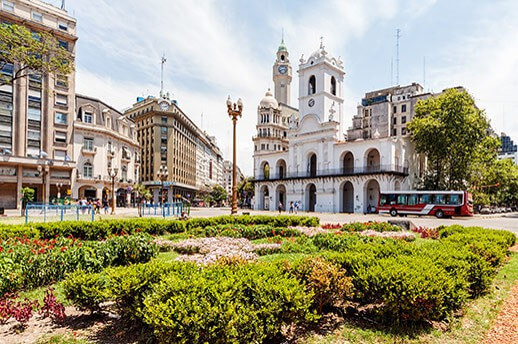Buenos Aires is the capital and cultural melting pot of Argentina, offering beautiful colonial buildings, vibrant street markets and soothing old-world cafes. The cosmopolitan metropolis contains beautiful landmarks of distinctive European styling, offering travellers a range of sightseeing options to keep their itineraries busy. To learn more about bustling Buenos Aires before you visit, contact your personal travel manager today.
Plaza de Mayo
Plaza de Mayo is one of Argentina’s most famous landmarks, reflecting both the highs and lows of Argentina’s colourful history. The plaza, established in 1580 and Romanesque in style, derives its name from the May revolution in 1810, a movement that marked the start of Argentina’s independence from Spain. The colossal plinth crowned by an allegory of Liberty, was erected to mark the first anniversary of the reformation.
The plaza is the symbolic beating heart of Argentina and consequently the stage of major political demonstrations. The Mothers of the Plaza de Mayo, identifiable by their white headscarves, have been demonstrating peacefully at the plaza since the 1970s. The Mothers of the Plaza de Mayo are the grieving loved ones of left-wing supporters who were kidnapped, tortured and executed under the military junta led by General Jorge Rafael Videla.
La Boca
The European flavor of Buenos Aires is most notable in the neighborhood of La Boca, instantly recognisable through its rows of brightly painted houses. Historically the residents of Boca originated from Genoa, and were so proud of their Italian heritage that they successfully, albeit momentarily, seceded from Argentina and raised the Genoese flag in 1882. The traditionally Italian community has become an unofficial little Italy, with a wide variety of gourmet Italian restaurants opening in the area.
Caminito is an alleyway within La Boca that holds special historical and cultural significance. In the 19th century a stream flowed through the passageway and when this dried up a railway line was installed. When the line was abandoned the area become a dumping ground until Benito Quinquela Martin, a local artist and close friend of the famous tango composer Juan de Dios Filiberto , painted the walls pastel colours and erected a stage at one end. It was here that Tango was supposedly born.
Teatro Colon
Teatro Colon, also known as the Colombus Theatre, is a grand concert venue and a true Buenos Aires icon. Built in 1908, Teatro Colon is considered to have some of the best acoustics in the world – a claim upheld by the late Luciano Pavarotti.
The capacity of the horseshoe shaped Teatro Colon seats 2,500 people, making it larger than the Royal Opera House in London. To experience the best of this magnificent building, we recommend taking a guided 50-minute tour through the opera house, allowing you to discover the hidden secrets inside. The extravagant scarlet and gold interior contained by dazzling Italian architecture will blow you away.
Casa Rosada
The Casa Rosada, or widely known as ‘The Pink House’, is the 18th century presidential mansion of Argentina. The building, a national historic monument, sits to the east of Plaza de Mayo and contains a museum of objects relating to previous presidents.
This lavish home was designed in a neoclassical architectural style, characterised by the large weight bearing columns at the entrance. The portico, another consistent feature of neoclassical architecture, was commissioned by President Rivadavia in 1825 to commemorate Argentinian independence. In an attempt to diffuse political tensions President Sarmiento painted the palace baby pink, a blend of the red and white worn by Argentina’s opposing political parties.
The interior is typically flamboyant, awash with gold leaf and finely detailed depictions of preceding president. The president’s office has two particularly grandiose chandeliers and the Salon Blanco has a beautiful brass representation of the national coat of arms.
A picturesque South American destination, guaranteed to take your breath away, find out more about Argentina through your local, personal travel manager.

